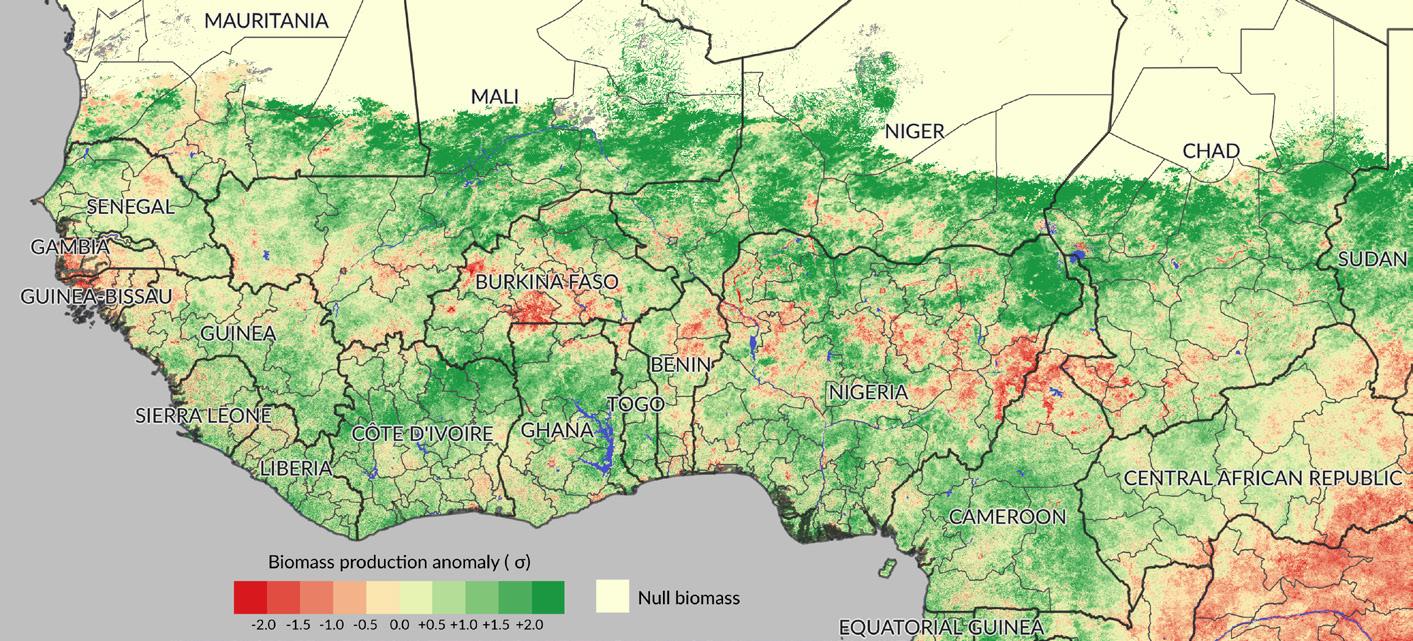
5 minute read
PASTORAL SITUATION
PASTORAL COMMUNITIES UNDER STRAIN
Pastoral communities were already facing many challenges long before the Covid-19 outbreak. These include significant fodder shortages in Mauritania and Senegal, and in parts of Mali and Niger as well as competition with farmers over access to land, water and resources. The security crisis disrupts pastoral activities in the Liptako-Gourma area and the Lake Chad basin with the closure of markets, reduced access to pastures, and limited transhumance, triggering massive displacement of pastoralists to peri-urban areas. With the Covid-19 pandemic, the pastoral situation has deteriorated further. Market closure and public movement restrictions heavily impacted pastoral and agro-pastoral communities. They were among the hardest hit by the Covid-19 crisis and strongly depend on external support. One out of four pastoral communities received some kind of support during the lean season. Mauritania launched a special agro-pastoral programme worth EUR 4.1 million. RPCA members mobilised Map 11. Fodder production anomalies compared to the 20-year average
Advertisement
- 50 – -25 -25 – -10 -10 – 10 10 – 25 25 – 50 50 – 100
Cross-border transhumance prohibited Inaccessible zones
Source: CILSS (2020), Impact of the Covid-19 pandemic on food & nutrition security, no. 1, April. Map: © CILSS.
to strengthen existing early warning systems, set-up new monitoring tools and co-ordinate responses. For example, the Association for the Promotion of the Livestock in the Sahel and the Savannah (APESS) conducted an analysis in 12 member countries to identify trends negatively affecting the agro-pastoral sector. The Réseau Billital Maroobé (RBM) networkset up together with Action Against Hunger (ACF) a monitoring tool, which provided weekly updated and analysed the economic impact of Covid19-related measures on pastoral communities in 11 countries. On a positive note, the new situation also showed that distance learning is working. This might offer new opportunities for education in pastoral communities in the future.
BIOMASS SITUATION
Map 12. Biomass production anomaly at the end of the rainy season, October 2019
While biomass was in generally good supply across the countries of the Gulf of Guinea, it was scarce in Sahelian countries. Some regions in Nigeria (Adamawa, Central zone, Northern zone, Southern zone) also crossed the warning threshold. The situation was worse in Mauritania and Senegal, which suffered from serious biomass shortages for the fourth consecutive year. An analysis by ACF, GNAP and RBM in February2020, showed that soils in 84% of southern Mauritania and 49.6% of northern Senegal are bare, with no grass for grazing. In addition, wildfires destroyed the scarce viable grazing land, thus exacerbating the vulnerability of pastoral households.Biomass production in the Sahelian strip has now recovered. The heavy rains in July/August 2020 (Page 36) had a positive impact on biomass production. Nearly all countries of the Sahelian strip reached a surplus of biomass production compared to 2019 levels (Map 13). This is good news for pastoralists who can expect a shorter pastoral lean season. However, there were once again significant biomass deficits in Mauritania and parts of Burkina Faso. The renewal or reconstitution of herds takes time. A single good year will not be sufficient to help recover dry spots in Mauritania and Senegal.
Source: Action Against Hunger (2019), October. Map: © ACF.
Map 13. Biomass production anomaly at the end of the rainy season, October 2020


ACCESS TO GRAZING LAND
Due to persistent insecurity, access to grazing land in the pastoral areas of most Sahelian countries was very difficult, particularly in the Liptako-Gourma area and the BokoHaram-affected areas. Several areas have become completely inaccessible and exceed the warning threshold of 75%. During the early lean season, access to grazing land was still possible in some areas of Niger (Goudoumaria, Manesora, Ngourti), Chad (Batha Est, Fitri Bourkou, Lac and Kanem) and Mali. In Chad, the extreme southern part next to the border with the Central African Republic was the only area that benefited from abundant grazing land. As of June 2020, access to grazing land became extremely difficult in many parts of Burkina Faso, Mauritania, Niger, Nigeria (states of Benue, Niger and Yobe) and some areas of Senegal. Access to pasture has improved overall with the beginning of the rainy season. Map 14. Accessibility and transhumance, June 2020
Source: CILSS (2020), Impact of the Covid-19 pandemic on food & nutrition security, no. 3, June. Map: © CILSS.

TRANSHUMANCE - REDUCED SEASONAL MOBILITY
Border closures and country-internal movement restrictions disrupted the region’s typical seasonal migration of transhumant herders and livestock between Sahelian and coastal areas, and within countries. While many transhumant herders had already left their home areas in the search of grazing land, their return has been complicated due to Covid-19-related movement restrictions.Crossborder transhumant populations needed support to return to their home communities in order to mitigate the risk of animal diseases and to prevent potential inter-community conflicts. In July 2020, some transhumant herders were still blocked in a host country due to border closures and insecurity. This was the case of some 150 transhumant herders with nearly 10 000 heads of cattle from eastern BurkinaFaso, who were stuck at the border area of Togo (Kodjoare, Mandouri, Sagbeiebou). In June 2020, transhumance remained prohibited in nearly all parts of Niger, and disrupted in Burkina Faso, Ghana, Nigeria (states of Benue, Niger and Plateau), Mauritania and Senegal. The ban on transhumance between wilayas of Mauritania has been lifted. Movement restrictions led Map 15. Movement restrictions and livestock concentration

Sources: Action Against Hunger and Réseau Billital Maroobé (2020), newsletter, June. Map: © ACF/RBM.

to high concentration of livestock in many border areas (eastern Burkina Faso, northern Côte d’Ivoire, southern Mauritania, southern Niger, border areas between Benin, Burkina Fasoand Niger), increasing the risk of resource degradation, animal diseases and conflict with host communities. Long before Covid-19, the 2019-20 pastoral season was marred by Nigeria’s closure of its land borders with Benin and Niger, and Benin’s ban on crossborder transhumance, which started in December2019.




